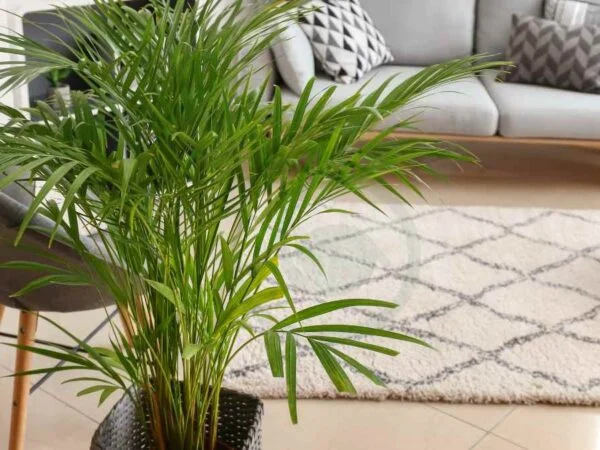Step into a world where nature meets elegance with indoor palm trees. These lush green palm houseplants bring a touch of the tropics to your living space, creating a serene oasis right at home. Dating back to ancient civilizations, indoor palm trees have been revered for their beauty and symbolism. From the majestic Majesty Palm to the versatile Parlor Palm, there's a perfect palm tree to suit every interior style and space, making them a popular choice for indoor spaces. Embrace the calming presence of these plants while enhancing your decor effortlessly.
Key Takeaways
- Choose the Right Palm: Select indoor palms based on your space, light conditions, and care abilities to ensure they thrive indoors.
- Provide Adequate Care: Maintain proper watering schedules, light exposure, temperature, and humidity levels to keep your indoor palms healthy.
- Regular Maintenance: Monitor soil quality, fertilize appropriately, and repot when necessary to support the growth of your indoor palm trees.
- Watch for Warning Signs: Be vigilant for common palm issues like yellowing leaves, pests, or root rot, and take prompt action to address them.
- Enhance Your Space: Indoor palms not only purify the air but also add a touch of nature and tranquility to your indoor environment.
- Create a Tropical Oasis: Transform your indoor space into a lush paradise by incorporating different palm varieties that suit your home's ambiance.
Benefits of Palms Indoors
Air Purification
Palms indoors serve as natural air purifiers, enhancing air quality by absorbing harmful pollutants present in the environment. These plants actively filter out toxins, such as formaldehyde and benzene, promoting a healthier atmosphere.
Tropical Oasis
Parlor palms can transform indoor spaces into vibrant tropical oases with their lush and elegant fronds. The presence of these plants adds a touch of greenery, creating a serene and relaxing ambiance reminiscent of a tropical paradise.
Healthier Living Environment
Indoor palm plants not only beautify living spaces but also contribute to a healthier environment by absorbing pollutants like carbon dioxide and releasing oxygen. This process helps maintain optimal air quality, benefiting overall well-being.
Buying Guide for Indoor Palms
Light Requirements
When choosing indoor palms, consider the specific light requirements of each variety. Some palm plants thrive in bright, indirect light, while others prefer low-light conditions. Research the lighting needs of refined miniature lady palms or houseplant palms before purchasing.
Humidity Needs
Indoor palms have varying humidity needs that are crucial for their health. Ensure you understand the humidity requirements of indoor palm trees to provide them with the optimal environment. Maintaining adequate humidity levels can prevent issues like brown tips on leaves or leaf drop.
Pet-Friendly Options
For pet owners, it's essential to select pet-friendly indoor palm plants to keep your furry friends safe. Look for non-toxic indoor palm options that won't harm pets if ingested. Consider species like parlor palms or bamboo palms that are safe for cats and dogs.
Selecting the Right Palm
Space Assessment
When choosing an indoor tree palm, start by evaluating the available space in your home. Consider the size of the palm you desire and ensure it fits well within the designated area. Some palm species can grow quite large, so it's crucial to select one that will not overcrowd your living space.
Maintenance Consideration
Different palm plants require varying levels of maintenance. Before making a selection, assess your availability for palm care. Some palms are more tolerant and can thrive with minimal attention, while others need regular watering, pruning, and fertilizing. Ensure to choose a dependable palm that aligns with your schedule and care abilities.
Aesthetic Preference and Care Capability
When deciding on an attractive palm, consider your aesthetic preferences and care capabilities. There is a wide range of popular palm trees available, each with its unique appearance and care requirements. Opt for a palm tree type that not only enhances the visual appeal of your indoor space but also matches your ability to provide the necessary care.
Care Essentials
Dusting Ones
Regularly dust the palm leaves to keep them clean and promote healthy growth. Use a soft, damp cloth to gently wipe down each leaf's surface. This helps the plant breathe better and absorb more sunlight for photosynthesis.
Ensure you reach both the top and bottom of the leaves to remove any dust or debris that may have accumulated. By keeping the leaves clean, you reduce the risk of pests infesting your indoor palm tree.
Monitoring Fan
Monitor the soil moisture levels of your indoor palm tree to prevent issues related to overwatering or underwatering. Check the soil's moisture by inserting your finger about an inch deep into the soil. If it feels dry, it's time to water your palm.
Avoid letting the soil become completely dry or waterlogged, as both conditions can harm the plant. Overwatering can lead to root rot, while underwatering can cause the leaves to wilt and turn yellow. Finding a balance in watering is crucial for the health of your indoor palm tree.
Pruning Fronds
Prune any dead or yellowing fronds on your indoor palm tree to encourage new growth and maintain overall plant health. Use sharp, clean pruning shears to make precise cuts at the base of the frond where it meets the main stem.
Removing dead or dying fronds not only improves the appearance of your palm tree but also prevents potential diseases from spreading. Pruning allows more energy to be directed towards healthy fronds, promoting lush foliage.
Water and Light Needs
Watering
Water indoor palms when the top inch of soil feels dry to the touch. Overwatering can lead to root rot, so ensure proper drainage in the pot. Monitor the moisture levels regularly to avoid underwatering or overwatering, which can stress the plant.
Lighting
Place indoor palms in bright, indirect sunlight to ensure healthy growth. Insufficient light can cause leggy growth or yellowing leaves. Rotate the plant periodically to ensure even exposure to light for balanced growth.
Seasonal Adjustments
Adjust watering frequency based on seasonal light changes and plant growth. During winter, when light levels are lower, reduce watering to prevent waterlogged soil. Observe your palm's response to environmental changes and adapt care routines accordingly.
Temperature and Humidity
Indoor Temperatures
Maintain room temperatures between 60°F and 80°F to ensure optimal growth conditions for indoor palm trees. Fluctuations beyond this range can adversely affect the health of your palms.
Humidity Levels
Increasing humidity levels around indoor palms is crucial for their well-being. You can achieve this by misting the leaves regularly or using a humidifier in the vicinity of the plants.
Draft Protection
Protect your indoor palm trees from drafts and sudden temperature fluctuations. These environmental factors can stress the palms, leading to issues with growth and overall health.
Soil and Fertilizer
Potting Mix
Use well-draining potting mix for indoor palm trees to prevent waterlogging and root rot. This type of soil ensures that excess water can easily drain away, preventing the roots from sitting in water and potentially rotting. A well-draining mix allows for proper aeration, which is crucial for the overall health of indoor palm trees.
Fertilizing Schedule
Fertilize indoor palms with a balanced liquid fertilizer specifically formulated for houseplants. During the growing season, typically in spring and summer, indoor palm trees benefit from regular fertilization. This practice provides essential nutrients that may be lacking in the potting mix, promoting healthy growth and vibrant foliage.
Repotting Frequency
Repot indoor palm trees every 2-3 years to refresh the soil and provide more space for root growth. As palm trees grow, their roots require additional room to expand and absorb nutrients efficiently. Repotting also allows for the inspection of the root system, enabling you to address any issues such as overcrowding or root bound conditions.
Repotting and Propagation
Repotting
When repotting indoor palm trees, it is essential to do so in the spring season. Palms should be repotted if they start to outgrow their current containers. This process allows the roots to have more space for growth and prevents them from becoming root-bound. Ensure that the new pot chosen for repotting has drainage holes to avoid water accumulation at the bottom, which can lead to root rot issues.
Propagation
Indoor tree palms can be propagated through various methods such as division or planting seeds in a warm and humid environment. Division involves separating a mature plant into smaller sections, each with its own roots, to create new individual plants. Another method is planting seeds, which requires a warm and moist setting to encourage germination. By providing the right conditions, seeds will sprout and develop into new palm plants over time.
Tips for Successful Repotting and Propagation
- Repot in Spring: Timing is crucial when repotting indoor tree palms. Spring is the ideal season for this task as it allows the plant to adjust to its new environment before the active growing period.
- Use Well-Draining Soil: Choose a well-draining soil mix specifically formulated for palm trees to ensure proper aeration and prevent waterlogging.
- Monitor Watering: Proper watering is key to successful repotting and propagation. Avoid overwatering, which can lead to root rot, by allowing the soil to partially dry out between waterings.
- Prune Dead Fronds: Before repotting or propagating, trim any dead or yellowing fronds to promote healthy growth and improve the overall appearance of the plant.
- Provide Adequate Light: Place newly repotted or propagated palms in a location with bright, indirect light to support their recovery and growth.
Common Palm Issues
Pests
Watch out for spider mites and scale insects that can infest indoor palms. These tiny pests can cause significant damage by feeding on the plant's sap, leading to yellowing leaves and stunted growth. To combat these pests, regularly inspect your indoor palm for any signs of infestation, such as webbing or sticky residue on the leaves. Consider using natural remedies like neem oil or insecticidal soap to control the pests without harming the plant.
Leaf Discoloration
Address yellowing or browning leaves promptly to prevent further damage to your indoor palm. Yellowing leaves can be a sign of overwatering, underwatering, inadequate light exposure, or nutrient deficiencies. Trim off any discolored leaves using sterilized pruning shears to promote new growth and maintain the plant's overall health. Ensure proper watering practices and adequate sunlight to prevent future leaf discoloration issues.
Nutrient Management
Monitor for signs of overfertilization or nutrient deficiencies in indoor palm plants. Overfertilization can lead to salt buildup in the soil, causing root burn and nutrient imbalances. Symptoms of nutrient deficiencies, such as yellowing or browning leaf tips, slow growth, or leaf drop, indicate the need for corrective action. Use a balanced liquid fertilizer specifically formulated for palms and follow the recommended dosage to avoid nutrient-related issues.
Summary
In caring for your indoor palm, you learned about its benefits, buying guide, selection process, care essentials, watering and lighting needs, temperature and humidity requirements, soil and fertilizer tips, repotting and propagation guidance, as well as common issues to watch out for. Now equipped with this knowledge, you can confidently nurture your indoor palm to thrive in your home. Remember to provide consistent care, monitor its growth closely, and address any problems promptly. By following these guidelines, you ensure that your indoor palm remains healthy and adds a touch of nature's beauty to your living space.
Frequently Asked Questions
What are the benefits of having indoor palm trees?
Indoor palm trees not only enhance the aesthetic appeal of your space but also act as natural air purifiers, improving indoor air quality by removing toxins. They can create a calming ambiance and add a touch of tropical elegance to your home or office.
How do I select the right palm tree for indoors?
Consider factors like available space, lighting conditions, and maintenance level when choosing an indoor palm tree. Opt for varieties such as Areca Palm or Parlor Palm that thrive in indoor environments with indirect sunlight and moderate watering needs.
What are the essential care tips for indoor palm trees?
To ensure your indoor palm trees thrive, provide them with adequate sunlight, water when the top inch of soil is dry, maintain proper humidity levels, and avoid over-fertilizing. Regularly dust the leaves to prevent dust buildup and promote healthy growth.
When should I repot my indoor palm tree and how can I propagate it?
Repot your indoor palm tree when its roots outgrow the current container or show signs of root rot. Propagate palms through division or by planting seeds. Use well-draining soil and provide warmth and moisture to encourage successful propagation.
What are some common issues faced when growing indoor palm trees?
Common problems include yellowing leaves due to overwatering, brown tips from underwatering, pests like spider mites or mealybugs, and fungal diseases. Monitor your palm tree closely for any signs of distress and take prompt action to address these issues effectively.
Image Source: Paid image from CANVA





